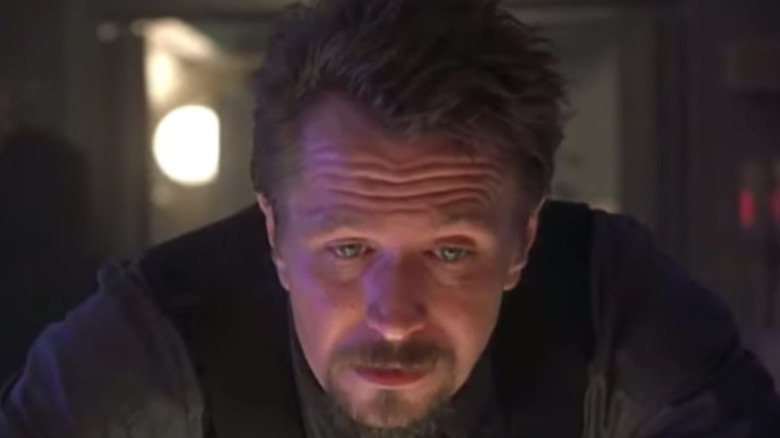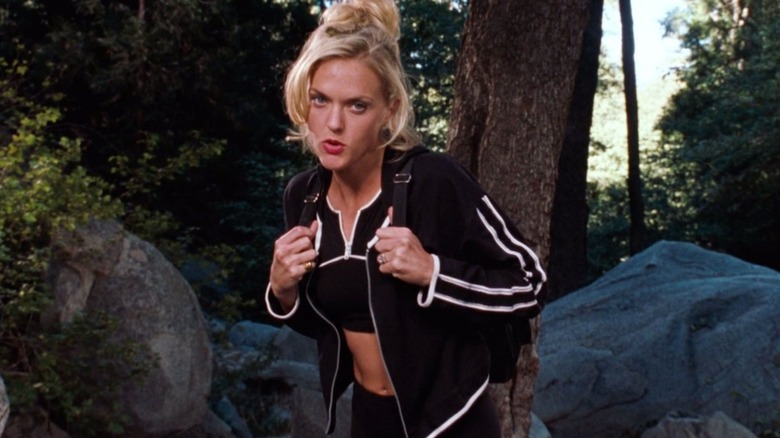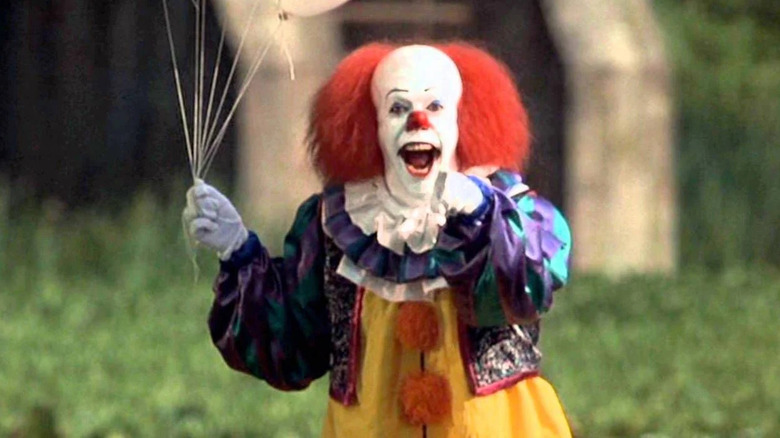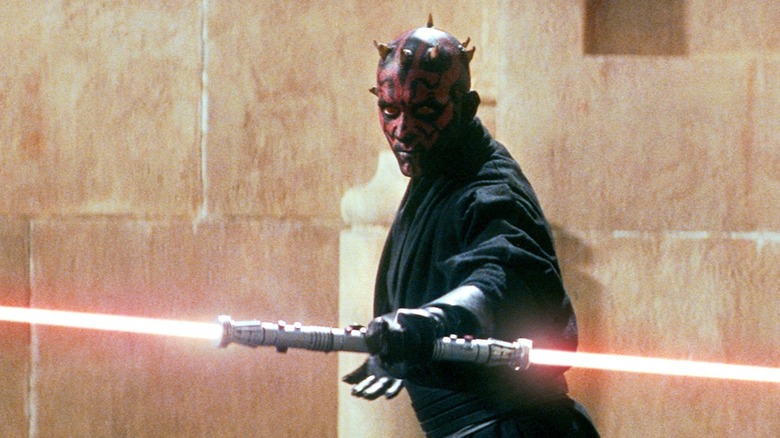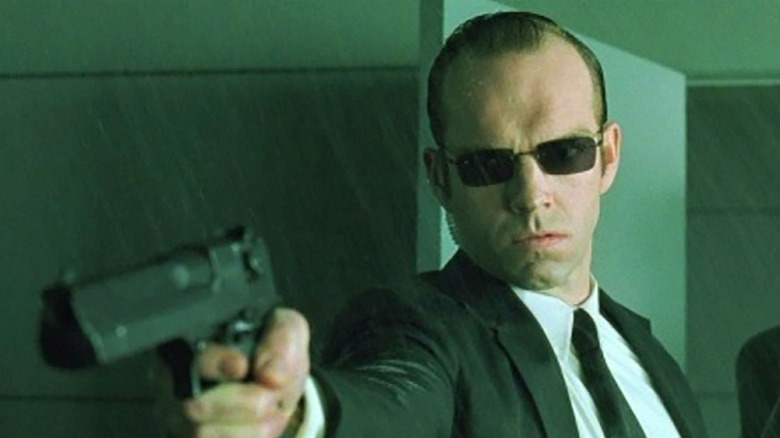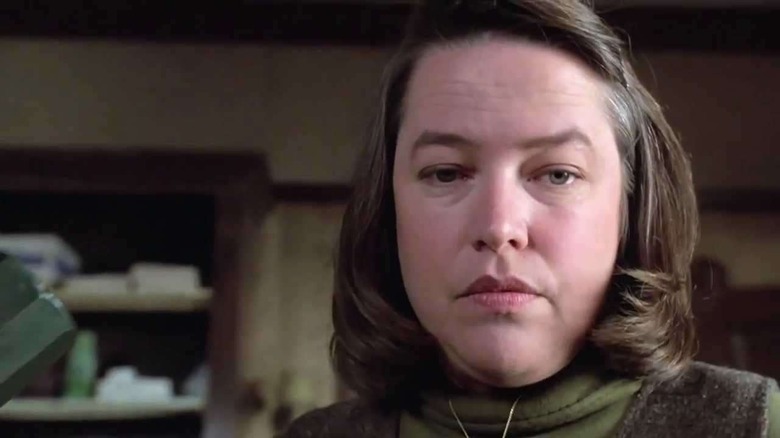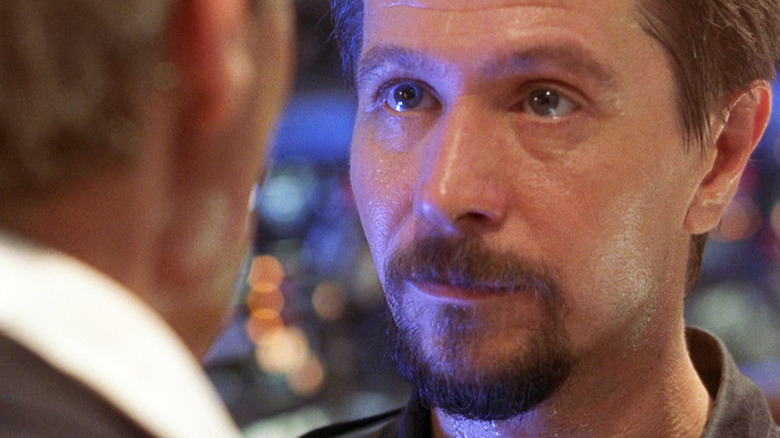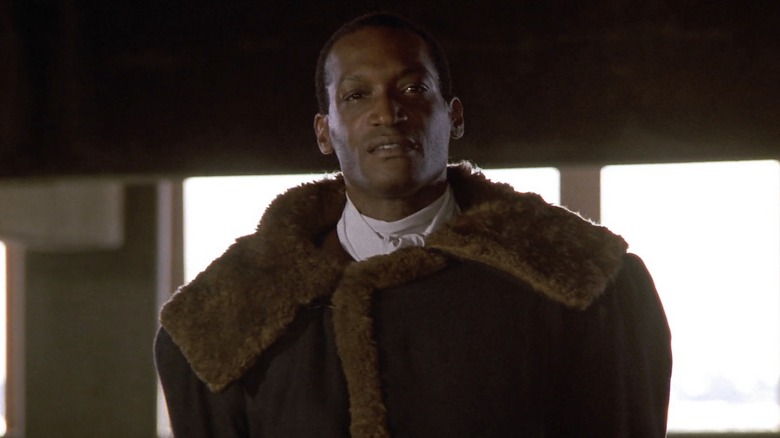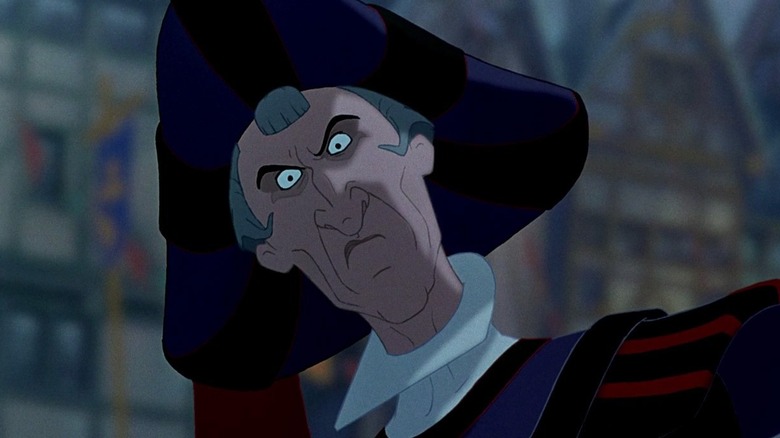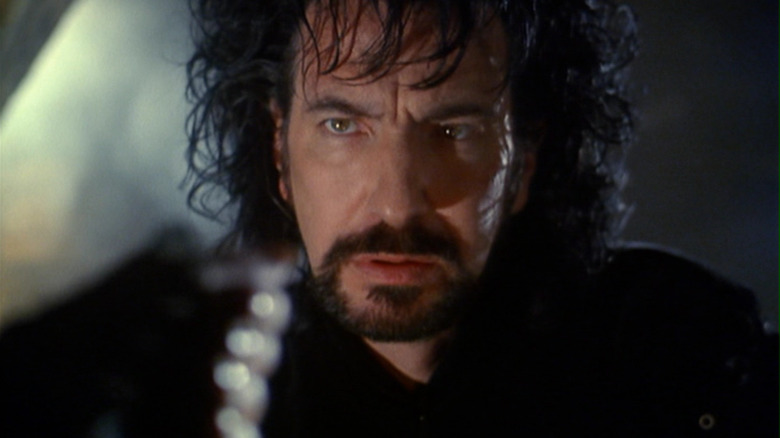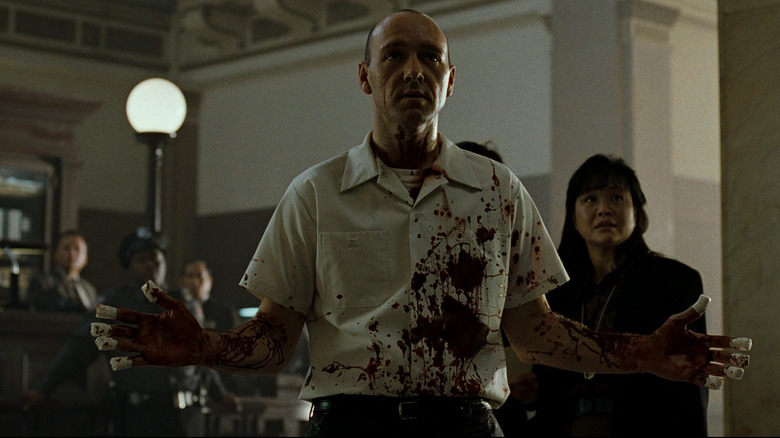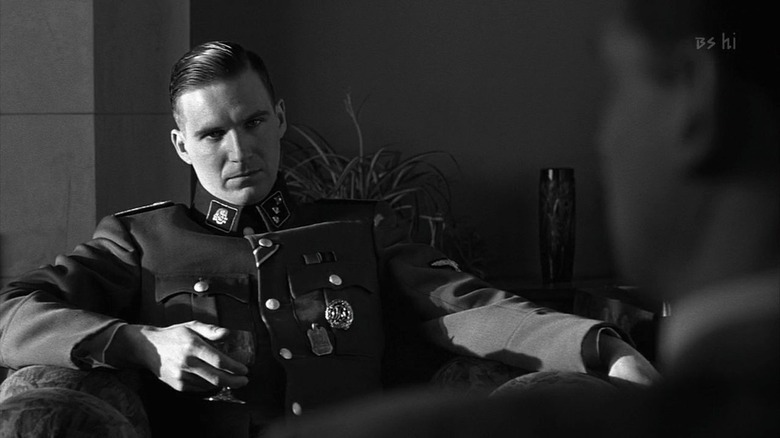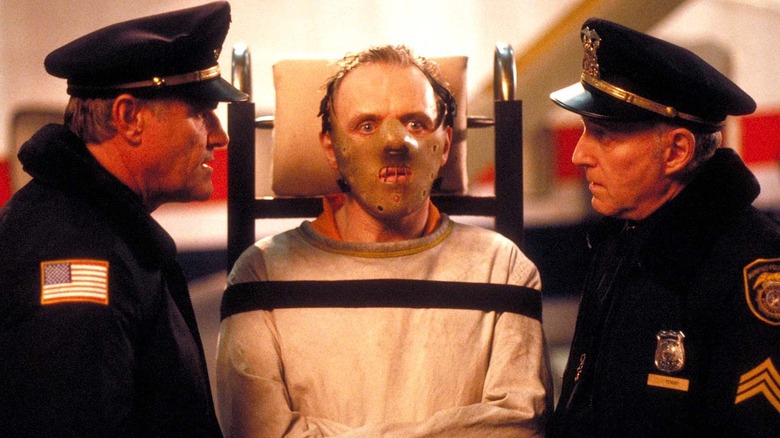The Most Iconic Movie Villains From The '90s
Between "Pulp Fiction," "Jurassic Park," "Schindler's List," "Toy Story," "Fight Club," and "Good Will Hunting," the '90s were one of cinema's strongest decades. So it's no surprise that these years produced more than their fair share of epic movie bad guys. In fact, there were so many timeless villains that plenty of worthy ones — the T-1000 from "T2: Judgement Day," Harry and Marv from "Home Alone," Cal Hockley from "Titanic" and Tommy DeVito from "Goodfellas" among them — simply couldn't fit on this list. Believe us, we tried.
But the ones that did are even greater. They're cruel. They're cunning. They'll stop at nothing to win. Some are even based on or inspired by real people. Some are hilariously entertaining, others are downright terrifying, and still others manage to be both. There's a wide variety of baddies here, but the one thing they have in common is that they're lots of fun to hate. These are the greatest movie villains of the 1990s.
Meredith Blake
"The Parent Trap" is a delightful reboot of the original 1961 film, in which two twins (played by a young Lindsay Lohan) learn of each other's existence at summer camp and hatch a plan to switch places, meet their other parent, and get them back together after decades of estrangement. Standing in the way of this, however, is Meredith Blake (Elaine Hendrix), a 26-year-old PR executive engaged to their much older dad, Nick Parker (Dennis Quaid).
Meredith's characterization isn't exactly subtle. It's not like she's a perfectly nice person who happens to complicate the twins' plan to reunite their parents. She's a loathsome, sneering woman who openly hates Hallie, Nick's daughter (who's actually Annie in disguise) and also hates Annie (who's actually playing Hallie) when she meets her. And you know what? It all gets a bit confusing. Point is, she gets her comeuppance on the camping trip at the end when the twins drag her bed onto the lake while she sleeps. When she swims ashore, she angrily demands Nick choose between her daughters or his. He, of course, picks his own.
As bad as she is and as dumb as it is to assume a father wouldn't pick his children if you give him an ultimatum like that, we can't say she deserved all the abuse she received. But it's also hard to sympathize, thanks to a hilarious, knockout performance by Elaine Hendrix, who makes her character a lot of fun to hate.
Pennywise
Stephen King's "It" — the 1990 TV movie, not the 2017 one — hasn't exactly aged well. It's an awkward, under-budget, melodramatic schlockfest filled with goofy writing and questionable performances. But there's one element at play here that truly works and even gives its 2017 counterpart a run for its money: Tim Curry's performance as Pennywise the Dancing Clown.
Derry, Maine's "Loser's Club" doesn't seem to find Pennywise all that amusing, seeing as how he's trying to kill them and eat the other children in town before returning to another 27-year hibernation in the sewers. But from the safety of our couches, we can admit that Curry's killer clown is every bit as hilarious as he is terrifying. In one scene, Pennywise torments an adult Richie Tozier (Harry Anderson) at the library by having blood-filled balloons that no one else can see burst in his face in an attempt to get him to leave town and stop meddling with his evil plans. But it's hard to be as scared as Tozier because Pennywise is sitting on the banister upstairs, tossing out lame jokes and just hamming it up. It's comedy gold, and it's far from the only scene where Curry brings the laughs.
At the same time, Tim Curry succeeds at haunting your nightmares despite the less than believable performances of his terrified victims. The red eyes and razor-sharp teeth help, but it's Curry himself who manages to so effectively channel King's ancient, otherworldly, shapeshifting demon.
Darth Maul
It's hard to think of movies that have been more examined than the "Star Wars" prequels. And as we all know, most of the commentary is negative because "The Phantom Menace" didn't live up to audience expectations. Given the anticipation for the first "Star Wars" movie since 1983's "Return of the Jedi," it would've been hard to. But between Jar Jar Binks, midi-cholorians, and the story's overall insignificance, many fans feel like the movie made inexcusable mistakes. We won't get into all of that here, though. The point is, there is one aspect of the film that's almost universally praised: Darth Maul.
Dark, mysterious, quiet, wicked cool, and frustratingly underused, Maul is the prequel trilogy's Boba Fett. Other than a brief duel with Qui-Gon Jinn in the desert, the horned, red-and-black tattooed Sith lord spends most of the film hunting the Jedi from afar or standing ominously behind Darth Sidious during conference calls. But the final fight between him, Qui-Gon, and Obi-Wan truly is something else. The reveal of his double-bladed lightsaber probably ranks among the most memorable moments in the entire saga, and the wild, acrobatic choreography that follows hasn't been matched since. We understand and respect that the next movies in the trilogy wanted to avoid making the mistakes of its predecessor, but lightsaber duels like these were the baby that got tossed with the bathwater.
Agent Smith
Hugo Weaving's performance as Agent Smith shouldn't have worked. "The Matrix" is a franchise that takes itself very, very seriously. If anything, most of the other performers underact, turning in almost wooden performances. On top of that, Smith is a literal robot with a serious job, portrayed by a man who often plays similar characters (see Elrond in "The Lord of the Rings"). Given all of that, you'd expect a cold, emotionless performance. And it would've been serviceable.
Instead, Weaving hams it up in every scene, sometimes stretching his face to Jim Carrey levels of rubber-faced absurdity as he howls with laughter or sneers at our heroes, plotting their demise. For reasons we can't put our finger on, it's wonderful. Perhaps it works at least partially because Weaving seems to understand and embrace the inherent silliness of "The Matrix" movies.
But don't think he's a joke. Smith — a computer program that's tasked with thwarting Morpheus, Neo, and Trinity's plans to free mankind from the titular virtual reality prison — is an extremely dangerous foe. He's a crafty, manipulative, virtually unkillable shapeshifter who's more than a martial arts match for our heroes — no pushovers themselves — until Neo embraces his destiny as the "One." Even then, Neo almost dies defeating Smith in 2003's "Revolutions."
Smith is simultaneously a cartoon and a chilling threat. It's hard to imagine anyone but Weaving striking that balance with such precision.
Annie Wilkes
Stephen King sure does like to fill his stories with personal experiences. It's common knowledge that many of his stories take place in Maine, where he grew up, and that several of his characters are authors like him. In "Misery," based on the 1987 King novel of the same name, protagonist Paul Sheldon is such a character. But it's the villain we're interested in. A globally recognized writer like King has undoubtedly had run-ins with obsessive fans. Specifically, Talk Film Society notes their angry reaction to his 1984 novel "The Eyes of the Dragon" inspired him to create Annie Wilkes, one of his most chilling creations.
Kathy Bates turns in one of her all-time greatest (and Oscar-winning!) performances as Wilkes, who rescues Paul Sheldon (a solid James Caan), her favorite author, after a car accident near her house. When he comes to, she explains that blizzard conditions are preventing an ambulance from picking him up and that he has to recover at her place for the time being. As gratitude — and much to Annie's delight — he lets her read the latest manuscript of his upcoming novel. Unfortunately, her distaste for the book's profanity and what happens to one of her favorite characters reveals her true nature: She's disconnected from reality, lying about the weather, and holding him hostage. Once the gloves come off, Bates' performance becomes truly, delightfully monstrous. And that ankle-hobbling scene is one of the most shocking moments in '90s horror.
Ivan Korshunov
The one thing that unites all Gary Oldman performances — since he never plays the same character twice — is his sheer dedication. Have you ever seen the guy phone it in? Neither have we. And boy, does he have some manic fun here as Ivan Korshunov, a terrorist ringleader who takes over the titular plane and uses its occupants as hostages in an attempt to negotiate the release of an imprisoned warlord. He's all smiles and handshakes when he flashes fake press credentials to board the craft, but once the gloves come off, he's one of the most menacing '90s villains. His temper is startling, and he's willing to go to any lengths to get what he wants — even executing hostages.
This is, of course, Harrison Ford's movie. In fact, other than "Indiana Jones," it might even be the Harrison Ford movie. He's in top form as the gruff, stone-faced President James Marshall, whose no tolerance policy on human rights abusers kicks off the movie's events (and makes him the greatest fictional movie president ever). In other words, Marshall winning at the end was never in doubt. Him strangling Korshunov and throwing him out of the hangar ("Get off my plane!") was predictable, but it was also a well-earned, crowd-pleasing, and delicious moment. Oldman was so much fun to hate in this movie that you can't help but cheer when he gets his comeuppance. That's the mark of a great baddie.
Candyman
Based on Clive Barker's short story "The Forbidden," "Candyman" follows a Chicago graduate student whose research on urban legends leads her to the titular one about a ghost who murders anyone who says his name in the mirror five times. It sounds like it could be the logline of a horror comedy or a standard, nothing-to-write-home-about slasher flick in the tradition of "Friday the 13th" or "Halloween."
But nothing could be further from the truth. Candyman — the ghost of a 19th century African American artist named Daniel Robitaille, who was brutally lynched for having an alleged affair with a white woman — is played to fearsome effect by Tony Todd. Unlike Freddy Krueger or Jason Voorhees, Candyman's appearance is less immediately frightening. He's a handsome enough man in a brown fur trench coat with a white cravat at the neck, gray pants, and polished leather shoes. The two most intimidating features are his towering height — at 6 foot 5 inches, he dwarfs most other characters — and the bloody, rusty meat hook where his hand should be. And beneath the coat is an even more gruesome mutilation: a hollowed-out torso housing a swarming hive of bees. Then he says his catchphrase in that haunted, whispered voice — "be my victim" — and all bets are off. You're on the run, but you won't get far.
Judge Frollo
Disney's "The Hunchback of Notre Dame" follows Quasimodo, a young French bell ringer who's confined to the Parisian cathedral he works in because of his physical deformities. Beautiful Esmeralda takes pity on the character and shows him that his gentle soul makes him beautiful, despite his appearance. But the cruel Judge Claude Frollo, who'd reluctantly adopted Quasimodo as a child after murdering his mother, is ashamed of the Hunchback. He often refers to him as a demonic abomination and is determined to keep him locked away from the public.
There are plenty of Disney villains from the '90s that could've made this list. Ursula from "The Little Mermaid" comes to mind, as does Sid from "Toy Story," Scar from "The Lion King," and Gaston from "Beauty and the Beast." But Frollo is simply in a league of his own. He's a cartoon, yes, but only technically. Spiritually, his self-righteousness and racist, genocidal hatred of the local Roma population channel the most insidious literary and historical villains to a degree that's simply shocking for a G-rated, animated Disney movie. Like many of history's most loathsome individuals, Frollo is blind to his own failings, seeing himself as above the law — the righteous, purifying instrument of a displeased God among filthy, sinning peasants. Few cartoon baddies (or villains in general) are as monstrous or as much fun to despise.
Sheriff of Nottingham
Alan Rickman's deliciously evil turn as Hans Gruber in 1988's "Die Hard" — the best movie villain of the '80s — put him in high demand for villainous performances moving forward. Notably, he was cast as the Sheriff of Nottingham in 1991's "Robin Hood: Prince of Thieves." And while the movie was lukewarmly received (Kevin Costner confusingly and distractingly made no attempt to speak with an English accent as Robin Hood), Rickman's performance was singled out for high praise. It's pretty much what you'd expect from him, but that's a good thing.
In the movie, the classic character of Prince John was rolled into that of the sheriff, so Rickman got to play both a corrupt, thieving politician and a violent enforcer. Like Rickman's other villains, the sheriff is cold, calculating, prone to angry outbursts, wicked smart (emphasis on wicked), wise, violent but not reckless, and unrestrained by morality. But it doesn't stop there. Knowing their actor could sell anything, the writers held nothing back in their characterization of the classic Middle Ages villain, even turning him into a devil worshiper (because why not?). Few other '90s baddies are so fun to loathe.
John Doe
"Se7en" follows two cops — a young hotshot (Brad Pitt) and a seasoned detective close to retirement (Morgan Freeman) — who hunt down an elusive, brilliant serial killer. At first, the killings appear random, but macabre clues left at the crime scenes reveal that each victim had committed one of the seven deadly sins and received what the killer thought to be a thematically appropriate punishment. A morbidly obese man is force-fed until his stomach ruptures (gluttony). A criminal defense attorney is forced to mutilate himself as punishment for greed. You get the point.
The investigation eventually leads to John Doe (Kevin Spacey). Unlike other villains on this list, who are fun, wacky, and prone to emotional outbursts or maniacal laughter, Doe is the opposite. But his being emotionless and soft-spoken doesn't make him less fearsome. On the contrary, it unnerves you to the core. Doe is fanatically committed to his own moral code and accompanying twisted logic. Unlike most crimes, he commits the acts not out of desperation, anger, or delusion but due to an unshakable faith in a violent, holy crusade. He is beyond reason, two steps ahead of the heroes at every turn, and thoroughly deserving of a spot on this list.
Amon Göth
The appearance of civilized professionalism set the Nazis apart from other historical killers. They woke up, donned a sharp suit, kissed the wife goodbye, and went to work. It just so happens that "work" was the industrialized mass murder of innocent Jews, as well as millions of other victims throughout occupied Europe. Ralph Fiennes embodied this nonsensical duality to frightening perfection as Amon Göth in Steven Spielberg's 1993 masterpiece, "Schindler's List."
In the movie, German businessman Oskar Schindler (Liam Neeson) often clinks wine glasses with the very Nazi officials he's secretly defrauding by staffing a munitions factory with Jews who would've otherwise been sent to die in the gas chambers and secretly sabotaging the shells they produce. Göth — a real-life commandant of the Krakow-Plaszow concentration camp in Poland — is his most frequent foil.
Fiennes' Göth revels in tormenting his captives. He snipes them for sport from his balcony and routinely has women and children put to death for the most insignificant offenses. Still, he's not incapable of reason. When Schindler challenges him to show true power by sparing lives on occasion, for example, he truly takes this to heart and gives it a shot. Nevertheless, he's terrifying because he truly doesn't understand that what he's doing is evil — he sees his victims as less than human and killing them as work that simply must be done, just like any other job. If that inhumanity doesn't keep you up at night, nothing will.
Hannibal Lecter
It takes some doing to be the most memorable character in a movie where you're neither the protagonist nor the antagonist. But Anthony Hopkins, who won an Oscar for his performance as cannibalistic criminal mastermind Hannibal Lecter in 1991's "The Silence of the Lambs," was up to the task.
Another factor that should restrain the character's sheer menace but doesn't is the fact that when hotshot FBI detective Clarice Starling (Jodie Foster) first meets him as part of her investigation into serial killer Buffalo Bill, he's already in prison. This isn't a comic book movie, which means there's no risk of him ripping apart the bars of his cell and devouring her. No, he's going nowhere, at least for now. It's the mind games he plays (as well as his predatory stare and that haunting hiss) that make him so chillingly memorable.
Lecter lacks basic human traits and yet understands people better than almost anyone alive. His experience as a psychiatrist before he decided to start eating people for fun gave him enough tools to read Starling like a book and negotiate a more favorable sentence for himself in exchange for insight into the criminal mind at work. By the end of the film, he devours his guards and escapes, setting up a few sequels. But those weren't necessary. Hopkins' Lecter was terrifying enough in the original film to become one of the greatest villains in cinematic history.
